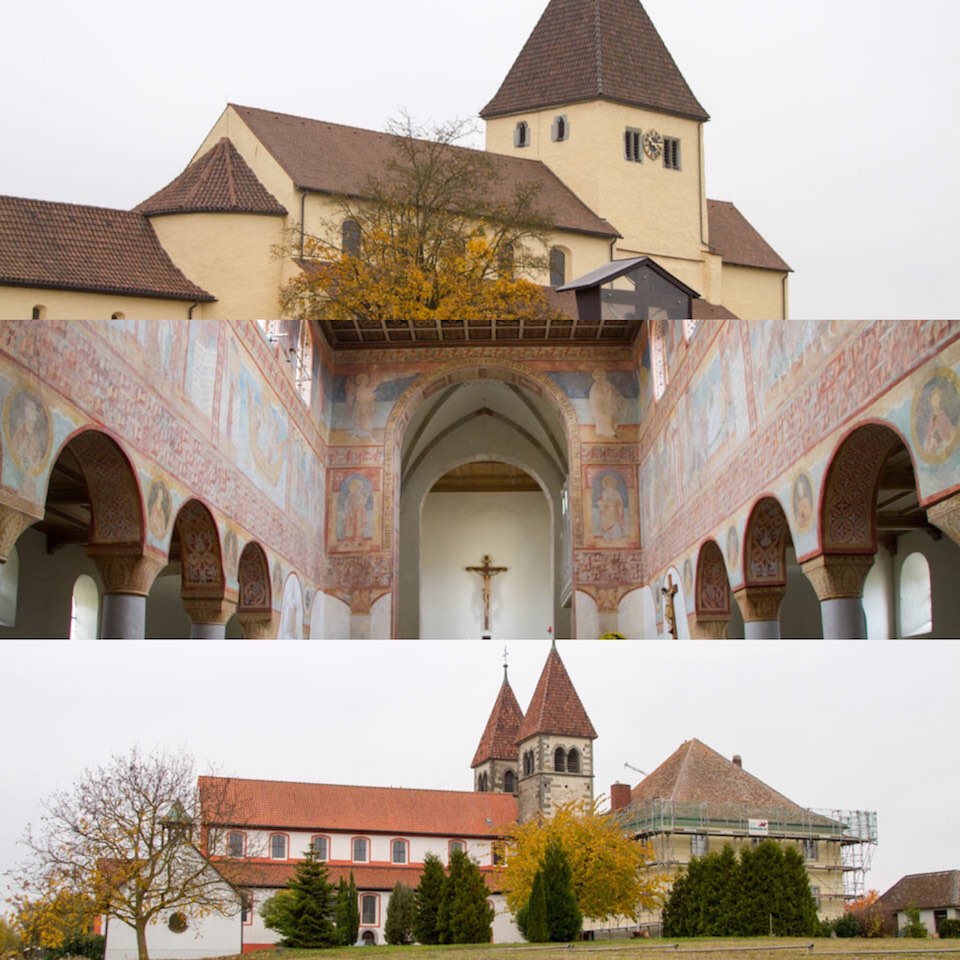
Visit date: 27 October 2015, weather: cloudy
The humble island actually has a long history.
To Reichenau, a small island in Lake Constance
With the help of the local people, we were able to solve the problem of having our car towed, and we were able to continue our trip again. Moreover, I was very thankful that I could resume sightseeing in about one hour schedule because I could solve the problem quickly.
さて、この日最初に向かったのは、コンスタンツ郊外にある「ライヒェナウ島」です。ここは、[highlight]「僧院の島ライヒェナウ」[/highlight]という名前でユネスコ世界遺産に認定されています。場所は、コンスタンツの東側、市街地からクルマで15分程度の場所です。
The shape of the island looks like this. By land, you can enter the island from the southeast side, lower left.

The island first appeared in history as a monastery in the early 8th century. A monastery was built in the middle of the island by a man named St. Pirminius.
その後、カロリング朝の保護のもとで発展を遂げ、修道院内には神学校、写字室、工房が建てられるなど、数百年間にわたり、宗教面においてもそして芸術面においてもその名をヨーロッパ諸国に轟かせていたそうです。つまり、初期神聖ローマ帝国時代における重要な修道院の一つということなので、ヨーロッパの歴史のなかでは、比較的古くからのものであると言えるでしょう。
また、このライヒェナウ島は、前日我々が訪問したボーデン湖の対岸にあるザンクトガレンと関係がありました。ライヒェナウの黄金期に当たる10世紀頃には、ハンガリーの脅威によりボーデン湖の対岸にあるザンクトガレン図書館がこの島に移管されてたこともあったようです。
However, from the 11th century onwards, with the rise of its St. Gallen monastery, Reichenau gradually lost its importance. In 1540, Bishop Constance became Lord Reichenau, and the monastery declined as the bishops took over the position. The monastery was completely secularized around the 19th century, ending nearly 1,000 years of service.
However, there are still very valuable records and letters on the island, some of which have been preserved in libraries and museums in Germany. There are also valuable murals in the island’s churches, which were restored at the end of the 20th century and are still there today.
In 2000, the last year of the 20th century, this historic island was inscribed on the UNESCO World Heritage List as the “Monastery Island of Reichenau”.
(Wikipedia、現地の観光案内所パンフレットより加筆)
The bridge from the mainland to Reichenau was completed in 1838, and the island is now accessible by land from the Konstanz side. We also crossed this end to the island.

It is very comfortable to run along the tree-lined road which is dyed yellow with autumn leaves. Only the weather is a little disappointing.
St. Georg’s Church at the entrance of the island
本土と島をむず部綺麗な並木道を進み、島に上陸すると一番最初に見えてくるのは「聖ゲオルグ教会」です。まずこちらから鑑賞することにしました。10世紀ころに建てられたということですから、ヨーロッパの宗教建築物の中でも比較的古い方といえます。

Although it is small and unpretentious from the outside, the inside of the cathedral has a very dignified atmosphere. The murals were restored in the late 20th century, but they are said to have been painted in the 11th century. This is a must-see point on this island.


The church had a book on the history of the island for sale (unattended), so I bought it for a donation to the church and to study later.
The Church of St. Peter and St. Paul at the northwest end of the island
次に我々が向かったのは、北西側にある「聖ペトロ・聖パウロ教会」です。聖ゲオルグ教会は島の入り口の南東側にあるので正反対側となりますが、島はとても小さいので、車だと5分程度で向かうことができました。かなり島の端のほうで、公共の交通機関もないので、観光客はまったくいませんでした。
There was a parking lot nearby and we parked there and then headed to the church. Cars are parked in addition to us, but it seems to belong to the locals. By the way, I thought it was a parking meter system, but the machine did not move at all, so I parked for free after all.

This is the outside view of St. Peter and St. Paul Church. It is a little bigger than St. Georg’s church.

The inside looks like this: it seems to have been rebuilt around the 18th century. So, it is a relatively common design.


There was also a pipe organ. This one was also relatively new, made in the 18th century.

The Church of St. Peter and St. Paul is new on the outside and inside, but its predecessor, a church dedicated to St. Peter and St. Paul, was actually built on this spot in 799, which is very old.

To the center of the island.
The last stop is the center of the island. Here you will find a tourist information center, a museum and the Münster (St. Mary and St. Mark’s Church). There was enough space for parking. In contrast to the church of St. Peter and St. Paul mentioned earlier, there were tourists. But they were few.
This tree in the center of town is very nice.

Well, anyway, we got off the car and headed for the first “museum” we found.

To be honest, there was no solid guide, just a little explanation in German, I didn’t know what it was (laughs). (laughs) I wonder if they were recreating the life of the island at that time?


But it was a good restroom break.
Then we headed to the tourist information center. This place was pretty solid. They also sold souvenirs. Here we finally got a map of the island. Until now, I had traveled only with information from TripAdvisor and Globe-Trotter (less than one page). I should have gone there first. In addition, there was no toilet in the tourist information center.

Finally, we went to the cathedral. It is said that the original was built in the 7th century. You can feel again how old the history of this island is. However, it seems that this cathedral was restored in the 18th century after it was no longer a bishop’s palace.


To be honest, even though it was the largest facility on the island, it was still a bit plain compared to the earlier churches we visited, St. George’s and St. Peter and St. Paul.
And is it the ruins of a monastery next to this cathedral? (I didn’t know because I couldn’t collect information. The outside of the building was quaint. But we couldn’t enter the inside.

That was it for sightseeing. It was a small island with no particular showy highlights, but looking back on it later, I could really feel the weight of its history. In fact, it would have been more interesting if I had acquired a variety of knowledge before I went there and when I was there. It’s hard to do even if you know what you’re doing…
駐車場に戻り次の目的地までの道のりを確認。しばらくロングドライブとなります。しかし、まだまだこの日の度は続きます。(続く)


